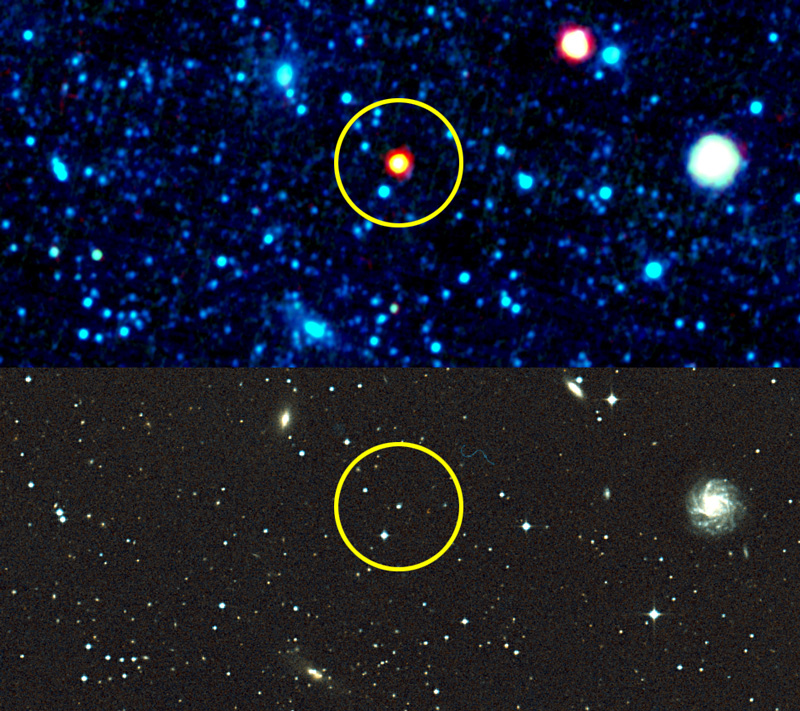



|
WISE Discovers Baby Galaxies in the Nearby Universe
The image shown here is of SBS 0335-052, a previously known blue compact dwarf located some 176 million light-years away in the constellation Eridanus. In the top view from WISE, it is very red compared to the stars and other galaxies also visible in the image. In the bottom view from the Digitized Sky Survey it is blue in color and rather unremarkable compared to the other galaxies in the field. Astronomers using data from the Wide-field Infrared Survey Explorer, or WISE, have discovered many galaxies in a class they had not expected to see in infrared light. Blue Compact Dwarf galaxies were first discovered in the 1960s, and named for their appearance in visible light surveys. They are small galaxies with an overall bluish color. They stand apart from other galaxies because they appear to contain very low amounts of heavy elements. In fact, the two galaxies with the lowest levels of heavy elements currently known (SBS 0335-052 and I Zw 18) are both blue compact dwarfs. Heavy elements are forged in the nuclear furnaces inside stars. It takes several generations of stars, and hence many tens of millions of years to build up a significant amount of elements heavier than lithium. This tells us that at least some of these blue compact dwarfs must be very young galaxies that have just begun to rapidly form stars, making them baby galaxies. This would also explain their color. Blue compact dwarf galaxies have a lot of star formation happening all throughout them. In a star forming region, the most massive and brightest stars are also the hottest, and therefore blue in color. Though they are relatively rare compared to smaller, dimmer, cooler stars, big blue stars greatly outshine their diminutive siblings. This gives star forming regions an overall bluish color in photos taken using visible light. In older galaxies, star forming regions often contain a lot of dust. Dust particles are usually composed of heavier elements like carbon, silicon, and iron. Dust particles absorb ultraviolet and visible light from newly formed stars, heat up from that absorbed energy, and then glow in infrared light. But because blue compact dwarfs do not have many heavy elements, they should not contain much dust. So, astronomers did not expect to find them standing out from the other hundreds of millions of galaxies observed in the WISE all sky survey. However, it seems that at least some blue compact dwarfs contain enough heated dust to glow brightly in infrared light, and WISE astronomers have been finding many of them. Here's where names can be confusing, because to WISE these active blue compact dwarfs do not appear blue. WISE surveyed in four infrared wavelengths: 3.4, 4.6, 12, and 22 microns. Dust glows brightest in the longer wavelengths because of its low temperature. That means blue compact dwarfs appear reddish in images from WISE where we color-code the wavelengths so that 3.4 microns corresponds to blue, 4.6 microns corresponds to cyan (blue-green), 12 microns corresponds to green, and 22 microns corresponds to red. Astronomers usually think of color in terms of brightness at different wavelengths. So when comparing brightness, if an object appears brighter at a shorter wavelength we call it "blue." Likewise when an object is brighter at longer wavelengths we call it "red." This is how astronomers can make a first pass at distinguishing one kind of object from another, by its color. In WISE images, active blue compact dwarfs appear reddish in color and because they are small and far away they also look like stars, just points of light. But stars appear to be bluish in color in WISE images. When an astronomer finds star-like objects that are red, it's a good bet that they are not normal stars. There are many kinds of galaxies and even some dust enshrouded stars that will appear red in WISE images. So, astronomers then have to use the hue of red and the context on the sky to distinguish them further. Using this color differentiation method WISE astronomers have found about 100 candidate blue compact dwarfs. To confirm that they are galaxies, astronomers must conduct follow-up observations with other observatories that can split the light of the object into its component wavelengths, making a spectrum. The spectrum of a star is very different from the spectrum of a galaxy, so it becomes easy to tell them apart. About 30 of the candidates have been confirmed so far as blue compact dwarfs. Because WISE is an all-sky survey, astronomers expect that they will find a significant fraction of all the active blue compact dwarf galaxies that exist in the nearby Universe. This will allow them to statistically analyze the properties of these galaxies, which should deepen our understanding of how galaxies form and grow. For more image options, go here
|
|
|||
